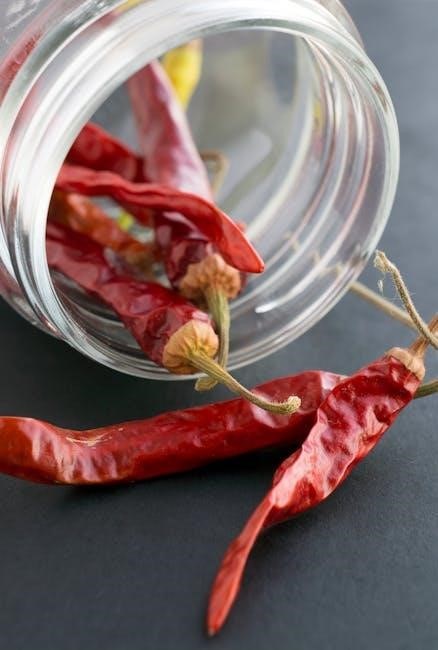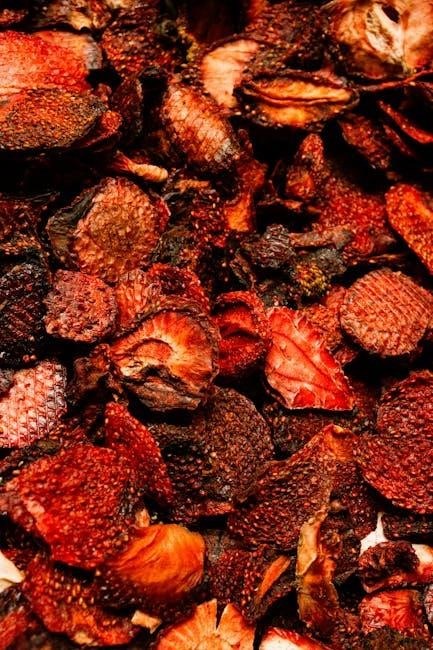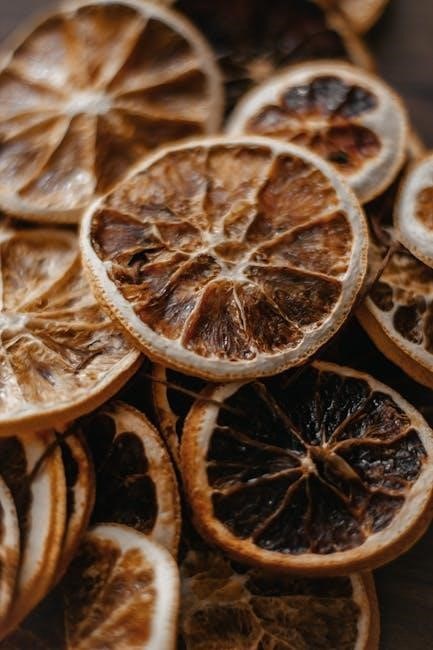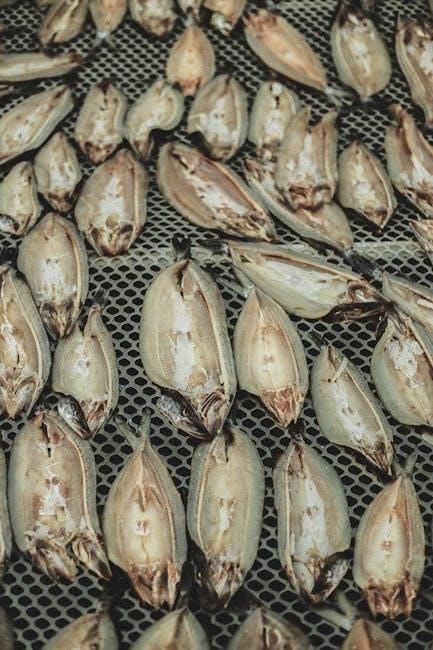Discover how to preserve flavors and nutrients with a food dehydrator. Learn essential techniques for drying fruits, vegetables, meats, and more to create healthy, long-lasting snacks and meals.
What is a Food Dehydrator?
A food dehydrator is a kitchen appliance designed to remove moisture from food through controlled heat and airflow. This process preserves food by preventing bacterial growth and spoilage, allowing for long-term storage. It is ideal for creating healthy snacks like fruit leather, jerky, and crispy vegetable chips. Unlike cooking, dehydration retains nutrients and natural flavors, making it a popular choice for health-conscious individuals and outdoor enthusiasts. The device typically consists of trays where food is placed and a heating element that circulates warm air evenly. Whether you’re preserving seasonal produce or making backpacking meals, a food dehydrator offers a versatile and efficient way to enjoy your favorite foods year-round.
Why Use a Food Dehydrator?
A food dehydrator is a valuable tool for preserving food, retaining nutrients, and creating healthy snacks. It allows you to enjoy seasonal produce year-round by drying fruits, vegetables, and meats. Dehydrating is cost-effective, as it reduces food waste and extends shelf life. It’s also ideal for making lightweight, nutrient-dense meals for camping or backpacking. Health-conscious individuals appreciate that dehydration preserves natural flavors and vitamins without added preservatives. Additionally, it’s a convenient way to prepare crispy snacks like chips and jerky at home. Whether you’re a homesteader, a busy parent, or a fitness enthusiast, a food dehydrator offers a practical and efficient way to enhance your diet and lifestyle.
Benefits of Food Dehydration
Food dehydration offers numerous benefits, including preservation of nutrients, reduced food waste, and extended shelf life. Dried foods are lightweight and portable, making them ideal for travel or emergency supplies. Dehydration retains natural flavors and vitamins, providing healthy snack options without added preservatives. It’s also cost-effective, as it allows you to enjoy seasonal produce year-round. Additionally, dehydration enhances food safety by removing moisture that bacteria and mold need to grow. This method is versatile, suitable for fruits, vegetables, meats, and even herbs. Overall, food dehydration is a practical and sustainable way to maintain a nutritious diet while minimizing food spoilage and saving money.

Choosing the Right Food Dehydrator
Selecting the right food dehydrator involves considering capacity, temperature control, and noise levels. Look for models with even drying capabilities and durable construction to suit your needs.
Key Features to Look For
When selecting a food dehydrator, prioritize features like precise temperature control, even drying capabilities, and noise levels. Look for models with multiple trays for large batches and adjustable timers for convenience. Ensure the dehydrator has a robust fan for consistent air circulation and a clear venting system to prevent moisture buildup. Durable construction and easy-to-clean parts are essential for long-term use. Some models offer digital interfaces for easy operation, while others include pre-set settings for specific foods. Consider the noise level if you plan to use it overnight. Additionally, check for safety features like automatic shut-off and secure lid locking mechanisms. These features ensure efficient, safe, and hassle-free dehydration experiences.
Capacity and Size Considerations
Choosing the right capacity ensures your dehydrator meets your needs without wasting space or energy. Consider how much food you typically process—small batches for personal use or larger quantities for family or storage. Dehydrators with 4-6 trays are ideal for most households, while 8-10 trays suit heavy users or bulk dehydration. Compact models are perfect for small kitchens, while larger units offer more flexibility. Measure your countertop space to ensure the dehydrator fits comfortably. Additionally, consider the height when stacked with trays, as some models can be quite tall. Selecting the right size balances convenience, efficiency, and practicality, ensuring you can dehydrate comfortably without overcrowding trays or sacrificing performance.
Types of Food Dehydrators
Food dehydrators come in various styles to suit different needs. Stackable tray models are popular for their versatility, offering 4-6 trays for home use or 8-10 trays for larger batches. Compact or round tray dehydrators are space-efficient, ideal for small kitchens. Vertical airflow dehydrators circulate air from the bottom up, promoting even drying, while horizontal airflow models direct air side to side, often preferred for precise temperature control. Some high-end models feature dual-zone heating for better performance. Portable options are great for camping or limited counter space. When choosing, consider your dehydration frequency, available space, and specific needs, such as preserving meat or herbs. The right type ensures efficient and consistent results for all your dehydration projects.
Preparing Food for Dehydration
Preparing food for dehydration involves washing, slicing, and pre-treating to ensure even drying and preserve quality. Clean produce thoroughly, slice uniformly, and apply pre-treatment methods like blanching or lemon juice to prevent spoilage and retain color.
Washing and Cleaning Produce
Properly washing and cleaning produce is crucial before dehydration to remove dirt, bacteria, and pesticides. Rinse fruits and vegetables under cool running water to ensure cleanliness. For firm-skinned produce like apples or potatoes, use a vegetable brush to scrub away dirt. Delicate items like herbs or berries should be gently rinsed in a clean water bath. After washing, pat dry with clean towels or paper towels to remove excess moisture, which helps prevent mold during dehydration. Ensure all utensils and surfaces are sanitized to maintain hygiene standards. This step is essential for safe and successful food dehydration, especially for meat and fish, which require extra precautions to avoid contamination.
Slicing and Uniformity
Uniform slicing is key for consistent dehydration results. Use a sharp knife or mandoline to cut produce into even thickness, typically between 1/4 and 3/8 inches, depending on the food; Uniformity ensures that all pieces dry at the same rate, preventing some from becoming overcooked while others remain undercooked. For fruits like strawberries or bananas, slice evenly to achieve crispy chips. For vegetables, maintain consistent thickness to avoid chewy or brittle textures. Meat and fish should be sliced thinly and evenly, especially when making jerky. Uniformity also enhances the final texture and flavor, making dried foods more enjoyable. Always slice across the grain for meats to improve tenderness. Proper slicing and uniformity are foundational for successful dehydration, ensuring the best taste and texture in your final products.
Pre-Treatment Methods
Pre-treatment is essential to enhance flavor, texture, and color retention during dehydration. Blanching vegetables in boiling water for 2-5 minutes destroys enzymes that cause spoilage and off-flavors. Fruits can be dipped in lemon juice or vinegar to prevent browning. For meats, pre-treatment involves slicing evenly and blanching to kill bacteria. Some foods, like herbs, may not require pre-treatment. Proper pre-treatment ensures even drying, prevents spoilage, and retains nutrients. Always follow specific guidelines for each food type to achieve the best results. This step is crucial for maintaining quality and safety in dried foods. By pre-treating, you ensure your dehydrated foods are flavorful, nutritious, and visually appealing. This method is especially important for meats and fish to avoid contamination. Pre-treatment is a simple yet vital step in successful food dehydration. It prepares foods for optimal drying and long-term preservation. Always prioritize pre-treatment for the best outcomes.
Dehydration Times and Temperatures
Master dehydration times and temperatures for perfect results. Adjust settings based on food type, monitor progress, and follow guidelines for optimal drying and preservation.
Understanding Dehydration Timelines
Dehydration timelines vary based on food type, thickness, and moisture content. Fruits like strawberries typically dry in 6-10 hours, while thicker slices may require 12-20 hours. Vegetables such as zucchini or carrots usually take 6-8 hours, but root vegetables like beets may need up to 10 hours. Meat jerky requires precise timing, often 3-4 hours, to ensure safety and tenderness. Herbs dry quickly, typically within 1-2 hours, while fruit leathers may need 8-12 hours. Monitoring progress and adjusting time as needed is crucial for optimal results. Always follow guidelines to avoid under- or over-drying, ensuring food remains safe and flavorful.
Temperature Settings for Different Foods
Temperature settings are crucial for successful dehydration. Fruits typically require 135°F to 140°F (57°C to 60°C) to preserve color and flavor. Vegetables usually need slightly lower temperatures, around 125°F to 135°F (52°C to 57°C), to prevent overcooking. For meats like jerky, a higher temperature of 160°F (71°C) is essential to ensure food safety and prevent bacterial growth. Herbs and spices dry best at lower temperatures, around 95°F to 105°F (35°C to 40°C), to retain their aroma and potency. Always use a food dehydrator with adjustable temperature control to tailor settings for specific foods. Proper temperature management ensures safe dehydration, retains nutrients, and achieves the best texture and flavor. Follow guidelines carefully to avoid under- or over-drying, especially for meats and fish, to maintain quality and safety.

Safety Guidelines for Dehydrating Food
Ensure food safety by washing hands, utensils, and surfaces before handling. Use proper temperatures, especially for meats, to prevent bacterial growth. Pre-treat foods to maintain quality and hygiene.
Hygiene Practices
Maintaining proper hygiene is crucial when using a food dehydrator to ensure food safety and prevent contamination. Always wash your hands thoroughly before handling food or the dehydrator. Clean and sanitize all utensils, cutting boards, and surfaces with soap and warm water. Regularly sanitize the dehydrator trays and compartments to remove any residue or bacteria. For meats and fish, take extra precautions to avoid cross-contamination by using separate cutting boards and utensils. After dehydration, store foods in airtight, clean containers to preserve freshness and prevent mold growth. Proper hygiene practices not only ensure the quality of your dried foods but also extend their shelf life and safety for consumption.
Safe Dehydration of Meat and Fish
Dehydrating meat and fish requires careful attention to safety to prevent bacterial growth and foodborne illness. Always handle raw meat and fish with clean utensils and cutting boards, and wash your hands thoroughly before and after preparation. Slice meats evenly, typically across the grain, to ensure consistent drying and tenderness. Pre-treat meats by blanching or marinating to destroy harmful enzymes and enhance flavor. Use a food dehydrator at a minimum temperature of 160°F (71°C) for meats and 145°F (63°C) for fish to ensure pathogens are eliminated. Avoid cross-contamination by using separate tools for raw and dried products. Store dried meats and fish in airtight containers to maintain quality and safety. Proper dehydration ensures delicious and safe jerky, fish snacks, and other preserved items for long-term enjoyment.

Popular Food Dehydrator Recipes

Explore delicious recipes like crispy fruit leather, savory meat jerky, and crunchy vegetable chips. Perfect for healthy snacks, these dishes showcase the versatility of food dehydration.
Fruits: Dried Fruits and Fruit Leather

Dried fruits are a popular choice for food dehydrators, offering a sweet and healthy snack. Sliced strawberries, apples, and mangoes dry perfectly in 6-10 hours, retaining their vibrant flavors. For fruit leather, puree your favorite fruits, spread thinly on trays, and dehydrate until flexible but dry. This method is ideal for creating portable snacks or baby food. Uniform slicing ensures even drying, while lower temperatures preserve color and nutrients. Experiment with combinations like strawberry-banana or mango-pineapple for unique flavors. Store dried fruits in airtight containers for year-round enjoyment. Fruit leather rolls up neatly for lunchboxes or on-the-go meals, making it a versatile and delicious way to enjoy seasonal fruits anytime.
Vegetables: Chips and Powder
Transform vegetables into crispy chips and nutritious powders using your food dehydrator. Popular choices like zucchini, beets, and kale yield delicious, healthy snacks. Slice vegetables thinly (1/4 to 3/8 inch) for even drying. Dehydrate at 135°F for 6-10 hours until crisp. For powder, dry vegetables until brittle, then blend into a fine texture. Use these powders as flavor enhancers in soups or sauces. Uniform slicing ensures consistent results, while lower temperatures preserve vibrant colors and nutrients. Experiment with seasonings for added flavor. Store chips in airtight containers to maintain crunchiness. Vegetable powders are versatile and can be used in various recipes, making them a great way to enjoy garden-fresh flavors year-round. This method is perfect for preserving surplus produce and creating convenient, nutritious snacks.
Meat: Jerky and Fish

Creating delicious jerky and dried fish is a popular use for food dehydrators. Slice meat evenly against the grain for tender results and marinate for flavor. Dehydrate at 160°F for 3-6 hours until dry and chewy. For fish, opt for lean varieties like salmon or cod, slicing thinly and seasoning before drying at 150°F for 6-8 hours. Ensure safe dehydration by pre-treating meat with vinegar or lemon juice to inhibit bacteria. Store jerky and dried fish in airtight containers to maintain freshness. These snacks are perfect for on-the-go meals or backpacking. Always prioritize hygiene and proper temperature control when handling meat and fish to avoid contamination and ensure food safety.
Specialty Items: Herbs, Spices, and Baby Food
Expand your dehydration skills with specialty items like herbs, spices, and baby food. Herbs retain their flavor and aroma when dried; simply place them in the dehydrator at 95°F for 1-2 hours. Spices can be dried to enhance their flavor or stored for longer freshness. For baby food, puree fruits, vegetables, or meats and spread thinly on trays. Dehydrate at 135°F for 3-6 hours until dry, then blend into powder for easy storage. These methods allow for healthy, customizable options for families and culinary enthusiasts. Always ensure cleanliness and proper temperature control when preparing these items to maintain safety and quality.
Maintenance and Cleaning
Regularly clean your dehydrator by washing trays with mild soap and warm water. Dry thoroughly to prevent rust. Check and clear vents for blockages to ensure proper airflow and efficiency. Consistent maintenance keeps your dehydrator hygienic and functioning optimally for years.

Cleaning the Dehydrator
Cleaning your food dehydrator is essential for maintaining hygiene and preventing bacterial growth. Start by unplugging the device and allowing it to cool completely. Remove all trays and wash them with mild soap and warm water. For tough residue, soak the trays before scrubbing. Wipe the exterior with a damp cloth, paying attention to buttons and controls. Regularly clean the drip pan or base to remove food particles. For deep cleaning, mix equal parts water and white vinegar in the dehydrator and run it on a low setting for 30 minutes. This helps sanitize and remove odors. Always dry the dehydrator thoroughly after cleaning to prevent rust. Consistent cleaning ensures optimal performance and longevity of your appliance.
Regular Maintenance Tips
Regular maintenance ensures your food dehydrator operates efficiently and lasts longer. After each use, clean the device thoroughly to prevent residue buildup. Check and clear vents and trays to ensure proper airflow; Lubricate any moving parts, like hinges, if recommended by the manufacturer. Store the dehydrator in a dry, cool place to avoid moisture damage. Avoid using abrasive cleaners or scrubbers, as they may damage surfaces. Replace worn-out parts promptly to maintain performance. For optimal results, follow the manufacturer’s maintenance schedule and guidelines. Regular upkeep not only extends the lifespan of your dehydrator but also ensures consistent drying results. By staying proactive, you can enjoy reliable performance and delicious preserved foods year-round.

Troubleshooting Common Issues
Identify and resolve common dehydrator issues, such as uneven drying or overheating, by checking settings, ensuring proper airflow, and consulting the user manual for solutions.
Food Not Drying Properly
Food not drying properly can be due to incorrect temperature settings, uneven slicing, or insufficient airflow. Ensure slices are uniform and within recommended thickness to promote even drying. Check that the dehydrator is set to the appropriate temperature for the specific food type, as lower temperatures may not effectively remove moisture. Overcrowding trays can also hinder airflow, so avoid stacking slices too closely. Pre-treatment methods, like blanching, can help preserve color and flavor while aiding the drying process. If food is still not drying, consider extending the dehydration time or adjusting the vent settings to allow more moisture to escape. Regularly monitor progress to achieve the desired dryness level for optimal results.
Dehydrator Not Heating
If your dehydrator is not heating, first ensure it is properly plugged in and the power button is turned on. Check the outlet to confirm it is working. Verify that the temperature setting is correct for the food being dried. A faulty heating element or thermostat could be the issue, so consult the user manual for troubleshooting steps. Clean the dehydrator to remove any blockages that might prevent heat circulation. If the problem persists, contact the manufacturer or a professional for repair. Regular maintenance, such as checking and replacing worn parts, can help prevent heating issues. Always follow safety guidelines to avoid damage to the appliance or risk of fire.
Mastering your food dehydrator unlocks a world of healthy, flavorful snacks and meals. With proper techniques and maintenance, you can enjoy preserved foods year-round, effortlessly and deliciously.

Final Tips for Successful Food Dehydration
- Always monitor dehydration progress to avoid over-drying, ensuring optimal texture and flavor retention.
- Store dried foods in airtight containers to maintain freshness and protect from moisture.
- Label and date containers for easy identification and rotation of stored items.
- Rehydrate dried foods by soaking in water or broth for recipes requiring moisture.
- Experiment with seasonings before dehydration for enhanced flavor in snacks like jerky or fruit leather.
- Keep the dehydrator clean after each use to prevent contamination and ensure longevity.
- Refer to your dehydrator’s manual for specific guidelines tailored to your model.
By following these tips, you’ll achieve consistent results and enjoy your preserved foods for months to come.
